Developer / Publisher
Novotrade International
Sega
Year
1992
Genre
Adventure
Mode
1 player
For Deutch, Nederlands, Español, Italiano, Suomalainen or Svenska, check out directly the .PDF of the original instructions booklet.
STORY
A Vast Sea of Discovery...and Danger!
Life was an adventure for Ecco, the young dolphin. The ocean seemed endless, with rolling breakers to race through! At high speed, Ecco could burst through the waves, leaping through the air – almost flying! Then, with a deep gulp of breath, Ecco would plunge down into the blue depths, where Shelled Ones hid in the coral crannies on the ocean floor.
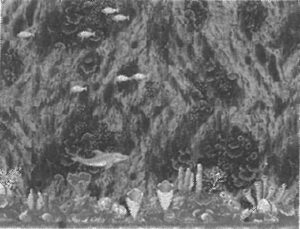
Ecco knew that dolphins couldn’t breathe underwater. Fish and coral stayed below the waves. But Ecco’s kind needed air. This was a puzzle, and Ecco wanted to learn the answer.
The ocean was full of songs. There were easy ones that came to Ecco naturally. These were the songs for calling dolphins and other singers of the watery world. There were new songs that took time to learn. These songs could open the Shelled Ones and scare off the Hungry Ones who roamed near the dolphins’ home. And then there were songs about just being alive and free!
The dolphins also had sad songs about stinging jellyfish, swift currents and rocky walls that trapped singers deep underwater. But the best ones were the proud, powerful songs about teeming schools of fish that filled the oceans and were good to eat, and about submerged, air-filled caves where a smart dolphin could breathe.
Five bright marks shone on Ecco’s sleek head. No other dolphin had these silvery spots. When the air was dark, the family would sing that Ecco’s markings matched five shining points far up in the sky. The song said that Ecco was special, a favorite of the ocean. Or maybe, it went on, the markings were just for looks, the way some fish had spots.
But the broad sky of the dryside also held a hidden terror. One day it attacked, without warning – a huge gust of swirling wind like a churning whirlpool of air and water. It tore all life from Ecco’s Home Bay. Singers and Shelled Ones and even the small fish were ripped, helpless, twisting in fright, into the high nothingness beyond. And then they vanished!
Only Ecco remained. In the flash of one leap, Ecco’s safe home, full of life and song, had become strange and silent. Everything had changed.
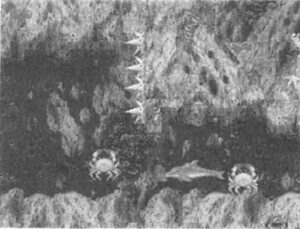
Now Ecco must fight to stay alive. Deadly hazards fill the wide oceans outside, but Ecco must find the lost dolphin pod. From the rip tides of the southern gulfs to the frozen chill of northern seas, Ecco must search through sunken worlds where razor teeth and poison stingers lurk in the dark depths.
Ecco, all alone, faces a treacherous quest to save the family. Only by fighting to survive can Ecco rescue the singers of the sea, and end a disaster that threatens the entire world.
Boutons
Take Control!
 Directional Button
Directional Button
(D-Button)
Moves Ecco right or left to leave the submerged cavern at the beginning of the game. Right takes Ecco to the start of a new quest; left goes to the Password screen.
Moves the highlight on the Password screen.
Exits Ecco’s Map and returns to the quest.
Makes Ecco swim in any direction. Hold down the button for cruising speed, and to make Ecco leap when breaking the surface of the water. Tap the button lightly to swim slowly through dangerous passages. Press Button C to speed up.
 Touche A
Touche A
(sonar)
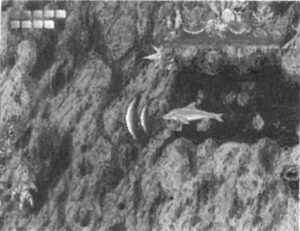
Makes Ecco sing. The song ripples out in the direction Ecco is facing. Songs can call to other singers and fight off danger. (See pages 38 – 40 for more details.)
Echoes back information about the surrounding ocean. Hold down Button A until Ecco’s song returns. Then Ecco’s Map will appear, showing important undersea features in the direction Ecco is facing. (See page 42 for more details.)
Exits Ecco’s Map and returns to the quest.
Exits any text screen.
Erases a letter on the Password screen.
 Button B
Button B
(Charge)
Makes Ecco dart forward in a short-range, high-speed attack. Ecco can charge schools of small fish to grab food, or attack enemies to make them dissolve.
Exits Ecco’s Map and returns to the quest.
Enters a letter on the Password screen.
 BUTTON C
BUTTON C
(SPEED SWIM)
Pumps up Ecco’s swimming speed. Press the button repeatedly, and then hold it down to maintain speed.
Makes Ecco flip. Use the D-Button to make Ecco swim toward the surface, then press Button C when Ecco jumps. The faster Ecco is going, the more spectacular the spin jump will be.
Enters a letter on the Password screen.
 Start Button
Start Button
Skips the opening sequence or the demo games and goes to the Title screen.
Exits the Title screen and goes to the submerged cavern.
Exits the Password screen and starts the quest from your password level.
Exits Ecco’s Map and returns to the quest.
Pauses a game during play; resumes a paused game.
How to play
A Look at Ecco's Life
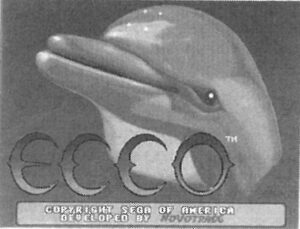
- 1) Right after the Sega screen, join Ecco in an ocean playground where carefree dolphins race the waves. In a few moments, the Title screen appears.
- 2) Wait at the Title screen to see the first game demo. Watch Ecco use intelligence and song to break through a rock barrier.
- 3) Keep watching to see two more demos (the Title screen appears between each one). Each demo shows how Ecco cleverly solves problems and stays healthy. Learn the strategies Ecco needs to survive the undersea dangers (You can watch the game demos again at any time for reminders.)
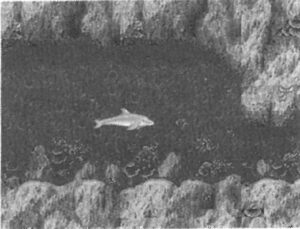
- 4) Press the Start button at any time to return to the Title screen. Press Start again to go to a submerged cavern, where Ecco waits to begin the long journey through the timeless seas.
- 5) Press the D-Button to the right to start Ecco’s quest from the beginning. If you have password, press the D-Button to the left to go to the Password screen. From there, you can start Ecco’s adventures from somewhere in midjourney. (See pages 54 – 56 for details.)
Disaster!
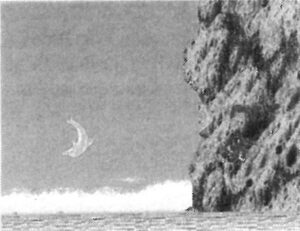
Live a dolphin’s carefree life in the pleasant waters of Ecco’s home. Splash and play! Dive deep to explore the curiosities of sea life on the ocean bed. Speed back and forth in silvery races. Sing, and let your songs return in the pictures of Ecco’s Map. Teach yourself to leap. Then learn to flip. With a swish of your fluke you can jump higher…and higher…
Wham! The sky flashes red. A great wind of water rips everything upward, tearing the life out of the sea. Up they whirl – singers and shells and all that moves in the ocean. They twist in a spinning funnel, swirling skyward, and they’re gone!
Just as suddenly, silence descends. Only you, Ecco, are left, alone in the watery emptiness that now seems far too big. As you dart here and there, searching the surface and plunging to the bottom, you realize the terrible truth: Everyone has vanished.
Who or what has taken your family Where have they gone? And why were you spared?
Your wandering begins. No matter how long it takes, or where it takes you, you must find your pod. You will leave this once-safe harbor and travel as far as you need to go – even to the ends of the earth.
There is still a great deal to learn, to puzzle through, and to conquer on your immense journey. Find the channel that leads away, and start your quest!

Using Passwords

Every ocean level has a name and a password. You’ll see these on the text screen that appears when you start the level. Write down the information in the password notebook (see pages 74 – 76). Later, you can use the passwords to begin the game at any level you’ve already played. (Press Button A to exit the text screen.)
Note: Passwords change each time you restart a level. To return to a level, you can use any of its passwords; they all take you to the beginning of the scene.
To begin a game from somewhere in mid-journey, press Start at the Title screen, and then move Ecco to the left in the submerged cavern. The Password screen will appear.
TO ENTER A PASSWORD:
- 1) Use the D-Button to highlight the letter you want.
- 2) Press Button B or C to add that letter to the password at the bottom of the screen.
- 3) Press Start when the password is complete.
TO EDIT A PASSWORD:
- 1) Use the D-Button to highlight the left or right arrow.
- 2) Press Button B or C to highlight a letter in the password, and press Button A to delete it.
- 3) Use the D-Button to select another letter at the top of the screen.
- 4 ) Press Button B or C to add it to the password.
Using Passwords
Keep a record of passwords for the levels you reach. Use passwords to start the game from the last level you played, or to return to any level you want to play over.
Note: Passwords change when you replay their levels.
Items
Surviving the Seas
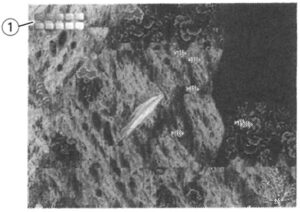
Staying Healthy
Like fish and coral, dangers abound in the open seas. Many things can and will hurt you, and when they do, you lose strength. If your health runs out, you’ll sink to the ocean depths, and you’ll have to start the level over.
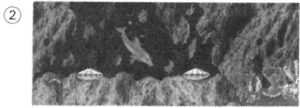
To stay healthy:
- Charge into a school of small fish for food.
- Find healing clams, known as the Shelled Ones. Figure out how to get and use their energizing gifts.
Keep yourself healthy, or you’ll soon be overcome by the next lurking or attacking foe.

Breathing
You need to breathe to stay alive. You can dive to the deepest parts of the ocean, and into the darkest waters, but you must always be close to air. Without it, your breath ebbs away. If you run out of breath, your questing ends, and you must start the level over.
You can breathe in two ways:
- Leap out of the water, either into the open air or into an air pocket you find in the rocky submerged caverns. You’ll regain full breath immediately. (See page 42 for help on finding air pockets.)
- Push your nose above water, especially in tight submerged pockets where you can’t jump. You’ll gradually recover breath. Try to regain full breath, but stay on watch for dangers that may force you to move on before your breath meter is full.
Keep your lungs filled with life-giving breath. Never take a chance on getting caught without an air supply.
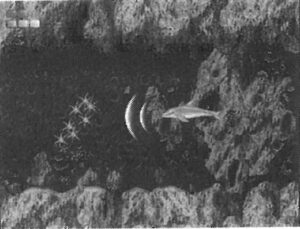
Singing
Use your dolphin songs to survive and thrive on your long journey. Sing to the sea life, to other singers and shells, to Glyphs (see pages 44 – 46) and to anything you don’t understand. Learn to listen to your songs; they all have different meanings.
Songs are powerful. They can:
- Call to other singers, who will respond with songs of their own. You may get clues, pleas for help or important directions. (Press Button A to exit a message screen.)
- Ward off the deadly Hungry Ones and other enemies.
- Get new songs, special powers and information from Glyphs scattered throughout the mazes of the sea.
Songs are Ecco’s sonar. Use them constantly to explore the dolphin’s world. Don’t be afraid to experiment; songs can do surprising things.

Mapping with Song
1) Ecco
2) Spike
3) Air Pocket
4) Glyph
Songs that echo back to you bring long-range information. This is called « echolocation. » When you hold down Button A, your song reverberates through the currents and caverns, returning to you with a map of your surroundings. (Press any button to exit Ecco’s Map and return to your quest.)
Ecco’s Map shows you:
- Your position and passages through the rocky walls.
- Prowling enemies and dangerous objects (shown as orange circles).
- Glyphs and other interesting objects.
- Healing clams and air pockets (shown as bubbles).
- Barriers and moveable rocks and shells (shown as orange blocks).
Make echolocation a habit. Send out echoing songs in all directions to get a full view of the ocean scene. If you can’t find something you need (such as an air pocket or escape route) in one direction, it may be close by in another. « Look beyond your eyes with your song. »

glyphs
Glyphs are mysterious crystals scattered in the ocean depths. The secrets they hold are as old and timeless as the sea itself. Figure out how to gain their powers and knowledge, by singing or charging, or just by swimming near them.
Some Glyphs give you messages. Others impart new songs you’ll need to continue the journey. Barrier Glyphs push you away and you must discover how to move them. Power Glyphs can bestow invincibility (you can’t be injured while the power lasts) or fill up your health and breath meters.
Watch for Glyphs wherever you go, and look for them with echolocation. Try not to miss any.
Take your time. Stay calm. Solve riddles by remembering what you’ve learned. Don’t get frustrated — there’s always a solution, and you can find it!
Rescuing Lost Dolphins
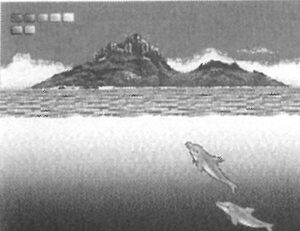
Three young dolphins have foundered in the craggy depths. You must find them all and guide them back to safe waters.
When you locate a lost dolphin, glide slowly over him, close to his back and a little ahead of him. Try to swim in the direction he’s going, but if he turns, that’s OK. Wait a few seconds, and he’ll turn around again. When he begins swimming like you, he’s ready to follow. Now you can lead him back to his pod.
Save ALL the lost dolphins. You’ll be rewarded with abilities that will help you for the rest of the quest. (You can only save one dolphin at a time.)
Enemies
Enemies
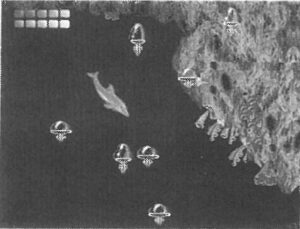
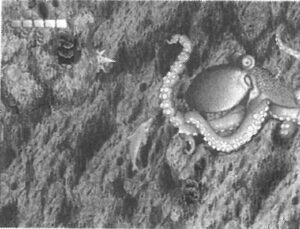
The sea is a beautiful yet dangerous place. Most undersea life is your enemy! Use your songs to ward off attackers, or charge to scare them away or dissolve them into sea foam. Some enemies, like the octopus, are so quick that only your wits or hint from a Glyph can save you.
Avoid enemies by swimming slowly. Always move cautiously in unexplored waters. Going slow is sometimes the fastest way to move ahead.
Barriers and Currents
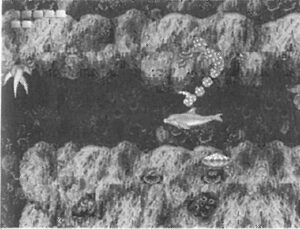
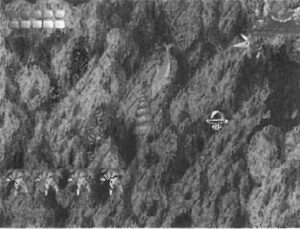
Rocks, shells and island barriers will block your progress. You may be caught in overpowering currents that are too swift to swim through.
For every obstacle, there’s a solution. It may be in a message or waiting in a Glyph. Search for moveable rocks, free-floating shells and unusual sea life. Then figure out how to use them. Try charging to break barriers or fight through currents. And remember: the shortest route is not always under water.
Bonus
Ecco's Family

Ecco is a bottlenose dolphin, whose family (or species) is remarkable for being almost totally unafraid of humans. They readily approach ships and boats, and are wonderful to watch at play. They are graceful and agile, rising in turns to « blow. » and they seldom if ever rudely jostle each other for position.
Bottlenoses group in small social units of about 15 dolphins or less. While feeding, each dolphin follows its own track, rising up in the water two or three times a minute. Occasionally before diving, dolphins will « lobtail, » loudly flapping their flukes on the water’s surface.
Usually, they dive for less than a minute, but their underwater stays have been clocked at as long as 10 minutes! At times, individual dolphins will suddenly « breach, » hurling themselves 16 feet or more into the air.
Dolphins make their home all over the globe in warm and temperate waters. One of their secrets to being able to live world-wide is their less- than-picky appetite. Bottlenoses eat 15 to 33 pounds of food a day, usually feeding in shallow waters on inshore bottom-dwelling fish. But they’ll also pleasurably dine on eels, catfish, sharks, rays, hermit crabs and shrimps.
Cooperation seems to be the rule with bottlenoses. On record is the story of a dolphin pod that chased a school of bluefish into a shallow bay. Then, they stationed two guards to keep the fish captive, while the rest took turns chowing down. In another report, three dolphins were seen in a tight cluster, two of them supporting the third, that was stunned, and assisting it to the surface to breathe.
DOLPHIN FACTS
- The earliest known ancestors of bottlenose dolphins were the squalodonts, the first true toothed whales, which flourished about 30 to 35 million years ago.
- The scientific name of bottlenose dolphins is Tursiops truncatus, meaning « cut-off face. » Bottlenoses belong to the superfamily Delphinoidea, named after a legend in which the god Apollo rose from the sea in dolphin form. The ancients commemorated this event in the constellation Delphinus, a group of five stars in the shape of a dolphin that can still be seen in the northern skies.
- The average length of bottlenose dolphins is 10 feet, their average weight is about 440 pounds (but they can reach up to 600 pounds), and their average life span is 25 to 30 years.
- Although mostly shallow-water feeders, dolphins are known to « sound » to depths of 1,000 feet or more. Dolphins off the west coast of Africa are said to dive to 2,000 feet over the steep edge of the continental shelf.
- Bottlenoses can reach a top speed of about 25 mph.
- Dolphins communicate with a wide range of sounds. They whistle, clap, grunt, chuckle, squeak, rasp,pop and belch. Bottlenoses can
- also produce a rapid series of clicks, up to 1,000 separate sounds per second. They « see » even the most complex shapes with their sonar. Each individual dolphin has a personal « signature whistle, » just like we each have our own voice.
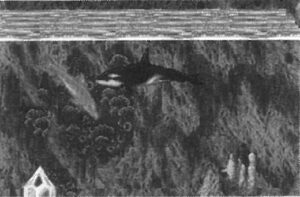
- Bottlenoses often school with other species, such as shortfin pilot whales. They sometimes accompany great right whales and humpback whales on their migrations.
- In self-defense, bottlenoses have been seen ramming large sharks hard enough to push them out of the water.
- In an aquarium, a dolphin watched a human diver cleaning the
viewing window. The dolphin then copied the diver, using a seagull feather held in its beak as a scraper. The bottlenose was so efficient and conscientious at the task that the human worker was never needed again.
An Incredible Sighting
Some miles ahead, there was a barrier of foam across the horizon. « There can’t be a reef here in the ship lane, » I said…..The reef seemed to sway. A half-mile from it we saw the splashing breakers were composed of leaping dolphins, the most formidable host that I had seen in a quarter of a century at sea.
He [the captain] rang the
bridgehouse bell to rouse everyone out to see them. The dolphin army wheeled and charged toward us in a storm comber that erupted twisting black bodies into the air. A nation of dolphins had gone mad before our eyes.
Dolphins, of course, are air-breathing mammals, and we were familiar with their light, measured prancing into the air to breathe. But these were shooting vertically high out of the water, bending and contorting in the leap. It was a mass high-jump contest, a bridal feast, or a frenzied victory celebration after some unknown war in the deep. …
For the rest of the day Calypso was steered by dolphins, obeying the whims of the flying phalanx spreading before us to either rim of the ocean. I took a rough sighting on their jumps. The tails were clearing 12 to 15 feet. As they fell, they twisted into awkward postures, as if vying to smack the water in the most ungraceful way. I tried to estimate how many there were.
At a given minute, there were about 1,000 out of the water on jumps that averaged three seconds. For one in the air, there must have been 19 in the water. Perhaps 20,000 dolphins formed the living reef.
— from The Living Sea by Jacques- Yves Cousteau, copyright 1963 by Harper & Row Publishers Inc., reprinted by permission of Harper Collins Publishers.